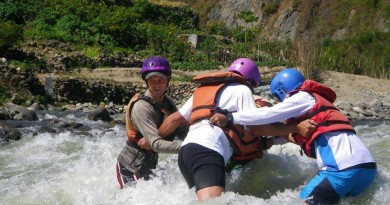Question of the Week #2: What is the proper way to cross a river?
Starting September 2011, I will be posting an answer to a weekly “Question of the Week” as a contribution to the education of hikers. Readers are free to experss their own opinions and reflections by commenting. For your questions, email me at gideon@pinoymountaineer.com!
This article is in response to the many questions that are being asked us of proper river crossing techniques, in light of the recent incident involving Adrian Alba. Having experienced many river crossings in the Philippines, including one that nearly claimed my life in Gasgas river in Mt. Sicapoo – an event witnessed by Cecil Morella of AMCI – I am really an avid subscriber of the dictum “Never cross a river when in doubt.” And the best person to have no doubts about the river is a local guide; each river is unique and it is best to have someone familiar with the river at your side if you are passing by a trail which requires a lot of river crossing.
I also believe that the best way to cross a river is to wait for it to subside. This is applicable when you are confronted with a river after heavy rains; instead of attempting to cross it immediately, it is best to wait out. Iron Lady Jo Steven and I did this in Mt. Thumbpeak in Palawan; we did a river crossing early the next day, with better results.
Yet, at times, when river crossings become very necessary, proper techniques are important to know. Most of my river crossing knowledge was taught to me by my earliest BMC instructors when I was a teenager (kudos to Sir John of the Makati Rover Mountaineers), and lately, New Zealand and US-accredited climbing instructor Jo Steven. Yet river crossing techniques are articulated succinctly by George Spearing, author of, “Dances With Marmots – A Pacific Crest Trail Adventure“. His exposition will provide bulk of the answer to this question. His outdoor experiences include hikes of the Pacific Crest Trail, (Mexico to Canada) and hikes of Great Britain, and the North Island of New Zealand. Here is his piece about river crossings:
River Crossing Safety
by George Spearing
River crossings can be deceptively hazardous. Even a very shallow swiftly flowing body of water can pack enough force to ‘skittle’ the unwary. If you cannot walk at the speed of a stick thrown into the river or if the river is swift and above knee height, then it could be hazardous to cross. If a river is in flood then wait for it to subside. Generally, in areas of snow try to cross early in the morning before snow melt has added to the flow of a river.
If in doubt as to whether a river is safe to cross, then find an alternative route or scout further up or downstream for a possible crossing or even a bridge. If Chris McCandless (Into the Wild by Jon Krakauer) had taken the time to scout a relatively short distance along the river that he thought was preventing his exit from the wilderness, he would have found a bridge and probably prevented his eventual tragic end.
Here are some methods for water crossings…
Crossing Alone
1. If possible, view the river from above to identify the shallowest point and smoothest area of river bed possible, avoiding submerged snags, boulders etc. Where a river widens, there may be shallower braided sections that allow a safer crossing. Do not attempt a crossing if large pieces of debris (logs, branches, etc.) are being carried downstream.
2. Keep your shoes on. Wet shoes are preferable to damaged ankles or feet. Do not cross wearing long pants, these will increase resistance to the current. Release the waist and chest strap on your pack before crossing. This way you will be able to free yourself quickly if you lose your footing or find yourself in a position where your pack is snagged and holding you down. It’s also well to remember that your pack has a certain amount of buoyancy and can serve as a flotation device if necessary.
3. Generally, the safest area to cross will be a straight section between bends in a river. If you imagine the river in the shape of the letter ‘S’ then the safest area to cross will be the middle of the ‘S’ between the bends. That way, if you should lose your footing, hopefully the current will carry you into the bank on one of the bends. Realize though, that water can be deeper and swifter at bends, so always look for the best ‘run off’ section of a river that will carry you to a safe exit point and not into danger if you lose your footing.
4. Use a strong pole or stick about five or six feet in length as support, placing it on your upstream side so that the current forces it into the bottom. Always keep two points of contact on the river bed at all times and cross diagonally downstream, resisting the current much like you would a strong wind. Take shuffling footsteps, feeling for the bottom. Try not to look down at the flowing water as this may upset your equilibrium, look ahead for the best possible route. Resist the temptation to grab at submerged or semi submerged rocks in transit, as this may upset your balance.
Crossing as a group
1. Members of the party stand in line abreast, each placing their hands behind the back of the person on either side of them and grasping the lower part of that persons pack shoulder strap. (or clothing if no pack is worn) This will ‘interlock’ the party. If a pack does not have a quick release buckle on the hip belt, then the hip belt should be left undone and clothing grasped instead.
2. Enter the water parallel to the current, with the strongest member of the party in the upstream position, this will break the flow for the others. Move with the upstream person just slightly ahead of the next person downstream and so on down the line. If a member of the party should break away during the crossing, the remaining members should maintain formation and either back out, or complete the crossing before attempting a rescue if necessary.
General pointers
With any crossing, ensure that important items are stowed in waterproof areas of your pack. (Plastic rubbish bags make good pack liners) If you lose your footing and are carried away, release your pack but hold onto it. Float with your head upstream, this will allow you to fend off from any obstacles with your feet.
Using a rope to assist in crossing is not generally a good idea and could be hazardous unless it is anchored correctly and a proper technique used. Ropes can hold people under the water, entangling the person crossing and preventing their ability to swim. They can also become snagged on the river bed or to a rock, pinning the person in the river. A rope may also end up pulling someone from the bank into the river.
Remember, flowing water is deceptively strong. Do not view river crossings lightly.







Leave a Reply
3 Comments on "Question of the Week #2: What is the proper way to cross a river?"
thanks sir gid,s this is very helpfull…
-reig-
thanks for sharing!malaki po maitutulong nito.
Amon
Good guide and information Sir. Please continue the sharing! 🙂